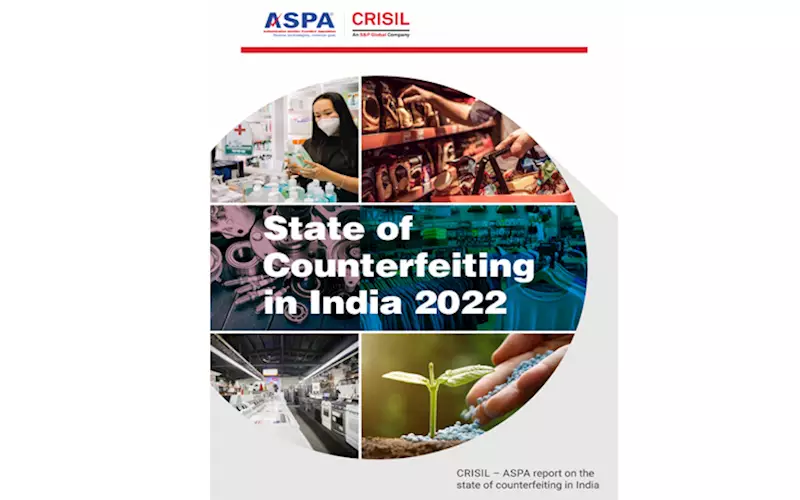25-30% of the market in India is counterfeit: ASPA-CRISIL report
Counterfeiting activities are impacting the sustainable growth of the major industry in India, including pharmaceuticals, FMCG, automotives, apparel, consumer durables/electronics, and Agri products, according to a new report released by ASPA & CRISIL.
25 Jan 2023 | By Dibyajyoti Sarma
The report by the Authentication Solution Providers’ Association (ASPA) and CRISIL is based on an independent survey conducted with consumers and retailers covering 12 Indian cities to gauge their perception of counterfeiting in several key sectors. The cities were Delhi, Agra, Jalandhar, Mumbai, Ahmedabad, Jaipur, Indore, Kolkata, Patna, Chennai, Bangalore, and Hyderabad.
An important finding of the survey was that consumer perception pegged the extent of counterfeiting at 25-30% of the market, higher than the general industry expectations. Counterfeiting is most prevalent in FMCG, apparel, and agrochemical sectors (~30%), followed by the pharmaceutical, automotive, and consumer durables sectors (20-25%).
The survey also reveals that almost 89% of consumers acknowledge the presence of fake products in the market and are often compelled to buy counterfeits for reasons such as sensitivity to price, demand-supply gap, desire to buy luxury brands, peer pressure, and social motivations.
However, nearly 27% of the consumers were unaware that the product was counterfeit at the time of purchase, making it more important to spread awareness about the issue and identification methods in fighting fakes.
Apparel (31%), FMCG (28%), and automotives (25%) are the top segments where consumers came across a counterfeit product, followed by pharmaceuticals (20%), consumer durables (17%), and agrochemicals (16%). Even after discovering that the product is fake, consumers take close to negligible action about reporting it.
Nakul Pasricha, president, ASPA, said, “Illicit goods trade stood at Rs 2.6-trillion in FY 2019-20 in India and affected almost all sectors. It is on the rise and heavily bleeding the country, industry, and consumers by large. An aware consumer holds the power to fight this menace; however, we must enhance consumer awareness about this issue. Consumers play the most crucial role in fighting against fakes. When many consumers are unaware of the actual threat from counterfeits, the country will never be able to harness the strength of active consumer participation in curbing the sale of fake products in the market.”
Suresh Krishnamurthy, senior director, CRISIL Market Intelligence and Analytics, said, “Counterfeiting is not limited to high-end luxury items. Even common items, from cumin seeds to cooking oil and from baby care items to medicines, are increasingly reported as counterfeit. An important finding of the survey was that consumer perception pegged the extent of counterfeiting at 25-30% of the market, higher than the general industry expectation.”
Pasricha added, “The country requires a comprehensive, proactive, and holistic counter approach. We need to make a significant change in increasing awareness, implementing authentication solutions, supporting these with robust track and trace infrastructure, and securing the supply chain against criminals. Since its inception, ASPA has made good progress in creating momentum in the fight against fakes in India, and we are committed to strengthening this momentum. We look forward to working with government departments, industry bodies, and institutions to develop more avenues to make India’s fight against counterfeiting more powerful.”
Key takeaways
- ASPA and CRISIL release their first-of-a-kind report titled State of Counterfeiting in India 2022
- The report is based on an independent survey conducted with consumers and retailers covering twelve Indian cities to gauge their perception of counterfeiting in several key sectors
- Consumers’ perception pegged the extent of counterfeiting at 25-30% of the market, higher than the general industry expectations
- Counterfeiting is most prevalent in FMCG, Apparel, and Agrochemical sectors (~30%), followed by the Pharmaceutical, Automotive, and Consumer durables sectors (20-25%)
- Apparel (31%), FMCG (28%), and automotives (25%) are the top segments where consumers came across a counterfeit product, followed by pharmaceuticals (20%), consumer durables (17%), and agrochemicals (16%)
- Nearly 27% of consumers were unaware that the product was counterfeit at the time of purchase
- Almost 89% of consumers acknowledge the presence of fake products in the market, and 31% willingly purchase counterfeit products











 See All
See All